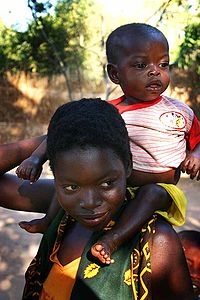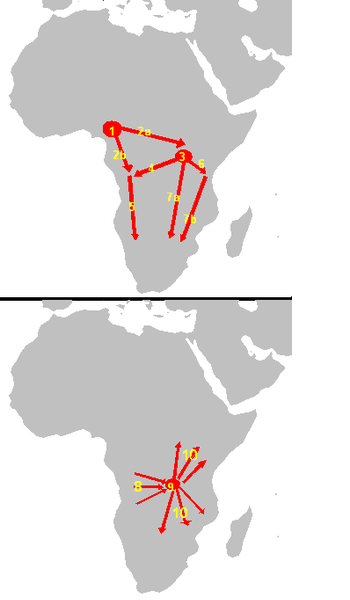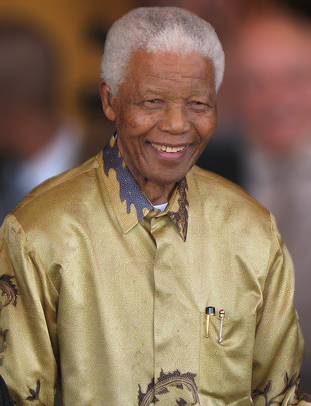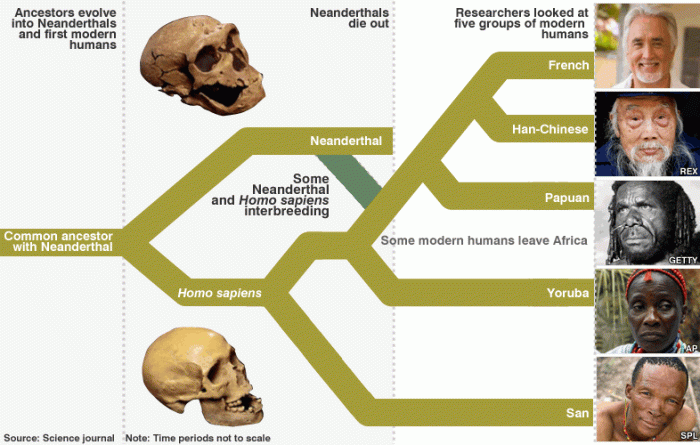As I’ve mentioned before, the famous Out of Africa (OoA) migration was likely preceded by an Into Africa migration, or at least, a Moving Through Africa migration.
Near as we can tell, based on the science at our disposal, H sapiens (humans, us,) evolved in Africa and then spread out from there.
But genetics (and other evidence) suggests that the oldest human split lies not between Africans and non-Africans, but between the San (aka Bushmen or KhoiSan) people of southern Africa and pretty much everyone else in the world.
But hold on. One frequently sees comments to the effect of “All modern humans descended from the San” or “The San are the most ancestral population alive today.” Bollocks. Look, you and your cousin are both descended from your grandparents. Your cousin is not ancestral to you, your grandparents are ancestral to both of you. You did not descend from the San because the San are living right now in southern Africa. They are not an ancient people known only from the architectural record, like the Yamnaya or Minoans. (Unless, of course, your parents actually are San. Then of course you are descended from the San.)
So what does this mean?
Humans–H Sapiens–arose around 200,000 years ago, somewhere or other in Africa. Around 100,000 years ago, the San split off from everyone else, and stayed isolated for almost 100,000 years.
The San look like this:

And their homeland is down in the green:

Their historic range was probably much larger than it currently is–note the little green dot over in Tanzania.
Here’s a different map’s opinion on the subject:
And here’s a map showing the locations of art attributed to the San / their ancestors:
Whether the San started in southern Africa, and everyone else left for northern Africa, leaving them behind, or the San started in northern Africa and then left for the south, leaving everyone else behind, I have no idea. Either way, one group left the other, and the split persisted, more or less, for almost a hundred thousand years.
I’ve mentioned before that the San are notably lighter-skinned than Africans from closer to the equator, like the Bantus:

Probably because the sun is just really harsh at the equator. You can see the current distribution of Bantus in orange on the brightly-colored map above.
Now, back to the story. Shortly after, the Pygmies split off, which I’m not going on to natter on about here because you can read the post I wrote about it. Around 70,000 years ago, some guys left Africa to explore the rest of the world. Around 40,000 years ago, some of those guys split, more or less, into Asians, Europeans, and their descendants.
Among other things, this means that the Batus are more closely related to Koreans, Australian Aborigines, and Native Americans than to the KhoiSan peoples. This is because the ancestors of the Bantus and the ancestors of everyone-not-from-Africa split up around 70,000 years ago, whereas the ancestors of the Bantus and the ancestors of the KhoiSan split 100,000 years ago.
If this is confusing, think about it like this: you and your brother are closely related, because you are only one generation away from your common ancestor, your parents. (In this case, Europeans and Asians are like siblings.) You are related to your cousins, but less closely–you share half your DNA with a sibling, but only 12.5% with a cousin. You and your cousin are two generations away from your common ancestor, your grandparents. In this case, Bantus are cousins to siblings Europeans and Asians. Your second-cousins are descended from your great-grandparents. (If you have cousins, and you both have kids, those kids are second-cousins.) Second cousins share only a quarter as much DNA again–3.13%. The San are like your second-cousins. They are also second-cousins to your brother, and also second cousins to your cousins. All of the siblings are more closely related to each other than to their cousins; all of the cousins are more closely related to each other than to their second cousins; Bantus are more closely related to Koreans than to the San.
And just in case you are still confused:
vs
If you’re still confused, here’s the Wikipedia page on kinship coefficients.
Please note that this is all a massive, massive over-simplification–obviously there are lots of groups in Africa other than the Bantus and the San–like the Yoruba. But “everyone in Africa other than the San and the Pygmies and people who’ve had Arab and other admixture” gets really clunky.
If you’ve been paying attention, you may have noticed that the green and orange regions on the map above look awfully close together. How have the San been so isolated for so long if they’re living right next to the Bantus?
About 3,500 years ago–96,500 after they split–the Bantus did this:

1 = 2000–1500 BC origin 2 = ca.1500 BC first migrations 2.a = Eastern Bantu, 2.b = Western Bantu 3 = 1000–500 BC Urewe nucleus of Eastern Bantu 4–7 = southward advance 9 = 500 BC–0 Congo nucleus 10 = 0–1000 AD last phase (from Wikipedia)
The Great Bantu Migration.
Why? I don’t know.
With their larger builds, superior weapons, and more complex social systems, the Bantus appear to have dominated the shit out of everyone they met, until they massacred the wrong guys:

Yes, they ran right into the Afrikaneer (Dutch) Boers, trekking northward from Cape Town, South Africa. And the Boers had guns.
Never bring a spear to a gun fight.
In the end, though, the Bantus won. They have the overwhelming numbers, after all.

The San are still around, but their territory has dwindled severely; some managed to survive in the Kalahari desert, a place just too harsh for anyone else, but even this has not protected them, as farmers and ranchers have moved in and they’ve been forced into more sedentary lifestyles.
I’ve mentioned The Harmless People before; it’s an ethnography of the Bushmen. It has the whole, “primitive people have so much less crime than we do” thing going on, (hence the title,) but it’s still an interesting account of a quickly-disappearing lifestyle.
The book’s epilogue describes efforts to force the Bushmen onto reservations, where they have been encouraged to take up farming and herding. The account is depressing; the Bushmen seem to have been perfectly happy with their lives before, and ill-suited to agricultural toil. Alcoholism is rampant, as it is among everyone whose ancestors haven’t been distilling alcohol for thousands of years, and violent crime appears to be taking more lives.
Whether the San will continue existing or be completely absorbed by the unstoppable Bantu migration remains to be seen.




I’ve always thought that Mandela looked like a San.
By the way, Harpending, who did field work among the Bushmen, says that “San” is regarded by the Bushmen as derogatory.
LikeLike
I know; that’s why I prefer Bushman, but since a lot of the literature uses San/Khoi-San or some variant thereof, I use them, too, so my audience knows whom I’m talking about.
Some Inuit see “Eskimo” as an insult, and some Eskimo see Inuit as an insult. Some Indians prefer to be called Native Americans, and a slight majority of Native Americans prefer to be called Indians. Some Gypsies prefer to be Roma and some Roma prefer to be called Gypsies, and some prefer their particular tribal names, like Sinti. Some blacks prefer African American and some prefer black and one black person I know prefers Negro. And “Bantu” is considered a slur in South Africa, but is just an ethno-linguistic group here in US academic parlance.
You’ll never please everyone, so I just try to use terms my audience will understand, keeping in mind that no one in the US (or pretty much anywhere outside of Africa) means “San” as an insult.
LikeLike
Oh, and you are right, he does look kind of San. Wikipedia says he is Xhosa royalty, though, and Xhosa are Bantu-speakers. Could be some admixture, though. Plenty of time for people in the area to intermarry.
LikeLike
He was actually Xhosa, a Bantu mixed group. My brother said he looked more Bantu when he was young, but when he got older the San features started to become more apparent, weird.
LikeLike
[…] Source: Evolutionist X […]
LikeLike
Fascinating post as always! I am again enlightened. My first exposure to the San people was thru that old movie “The Gods Must be Crazy.” A heartwarming movie indeed, but probably a bit inaccurate :)
LikeLike
I loved that movie as a kid. Rented it over and over.
LikeLike
[…] isolated peoples, or archaic hominin admixture? Are the Pygmies Retarded? Some Notable Nigerians, Into Africa: The Great Bantu Migration, Why do Native Americans have so much Neanderthal DNA? South Africa, democracy, and the dangers of […]
LikeLike
[…] their relatives Brown: Canadian Indians Green: Bushmen/San Rose: North-East Africans Dusty Blue: Bantus Light Blue: Pygmies Magenta: Tanzanian hunter-gatherers Orange/Blue/Teal: Europeans […]
LikeLike
[…] 1,000 ago; successive waves of steppe peoples like the Turks and Mongols invading their neighbors; the Great Bantu Migration that began about 3,500 years ago; the spread of Polynesians through areas formerly controlled by […]
LikeLike
Os brancos são albinos de dravidianos.
Whites are albino Dravidians.
LikeLiked by 1 person
That is true. Giant albinos, following the Law of Westermann. Albinism was likely spread by sexual selection following the female line; i.e. men choosing albino women. However, natural selection works against albinism, but less so in the North. In Africa, albinism is outright deadly, but in Europe, it is harmless enough for sexual selection to win from natural selection.
LikeLike
[…] people are pastoralists. There were undoubtedly more of them in the past, before both Europeans and Bantus arrived in southern Africa. Some people think Bushmen look a little Asian, due to their lighter […]
LikeLike
[…] rest of humanity are the Yoruba, a single ethnic group chosen to stand in for the entirety of the Bantus. Bantus are the group that you most likely think of when you think of black Africans, because over […]
LikeLike
Who ever wrote this has some of his facts wrong, remember “Bloed Rivier”
LikeLike
[…] This is most likely the Great Bantu Migration, which I wrote about in Into Africa: the Great Bantu Migration. […]
LikeLike
[…] the Bantus have more in common DNA wise with Europeans then they do with the Bushman (KhoiSan) that the Bantus displaced and destroyed in South Africa. […]
LikeLike
Your nonchalance about the Khoi San and the Boers is rather telling! You must be a libshit communist!
LikeLike
[…] The Bantus are not the original inhabitants of central, western, and southern Africa–they conquered it, killing the original Bushman (San) and Pygmy inhabitants as they went. The “Taiwanese” […]
LikeLike